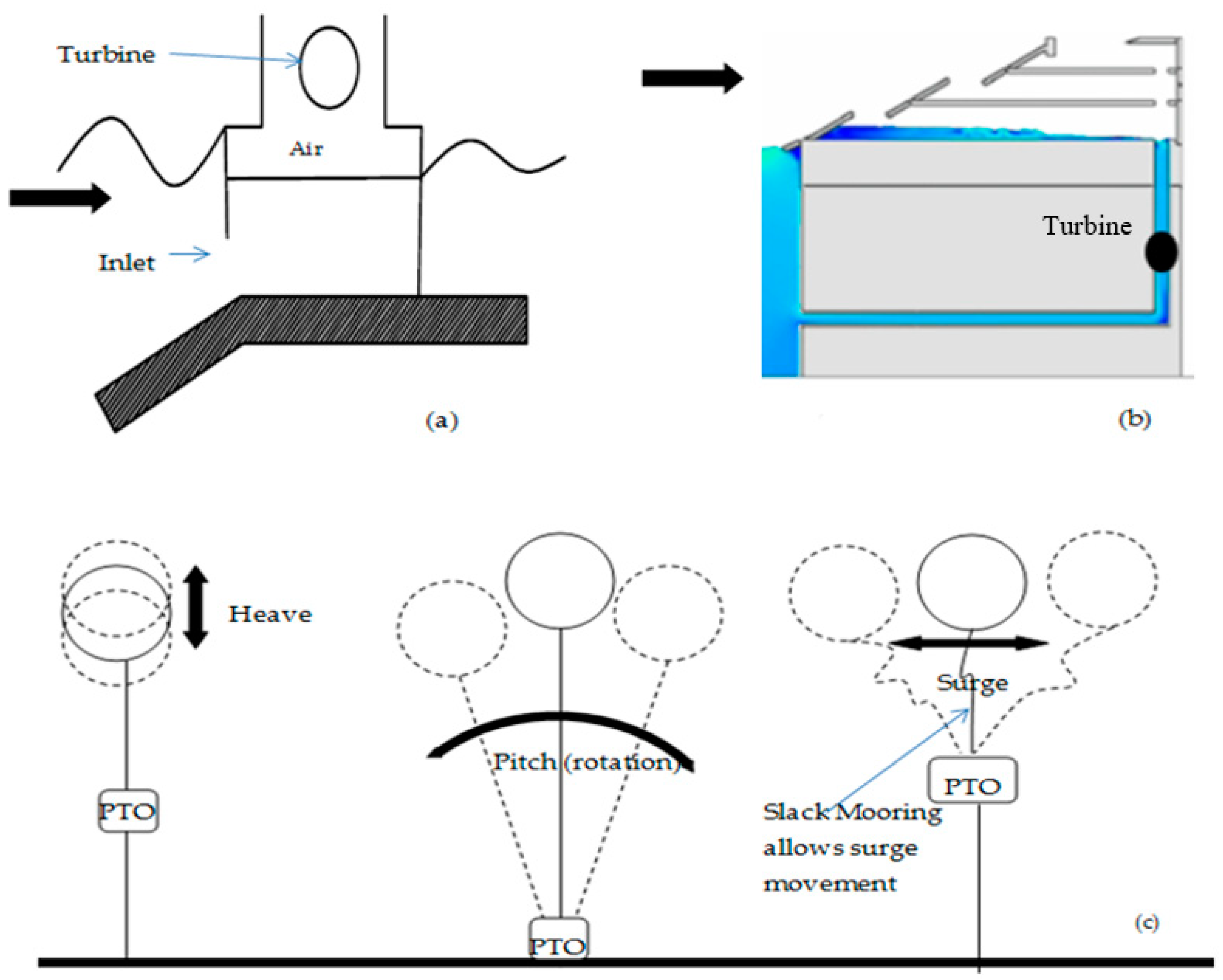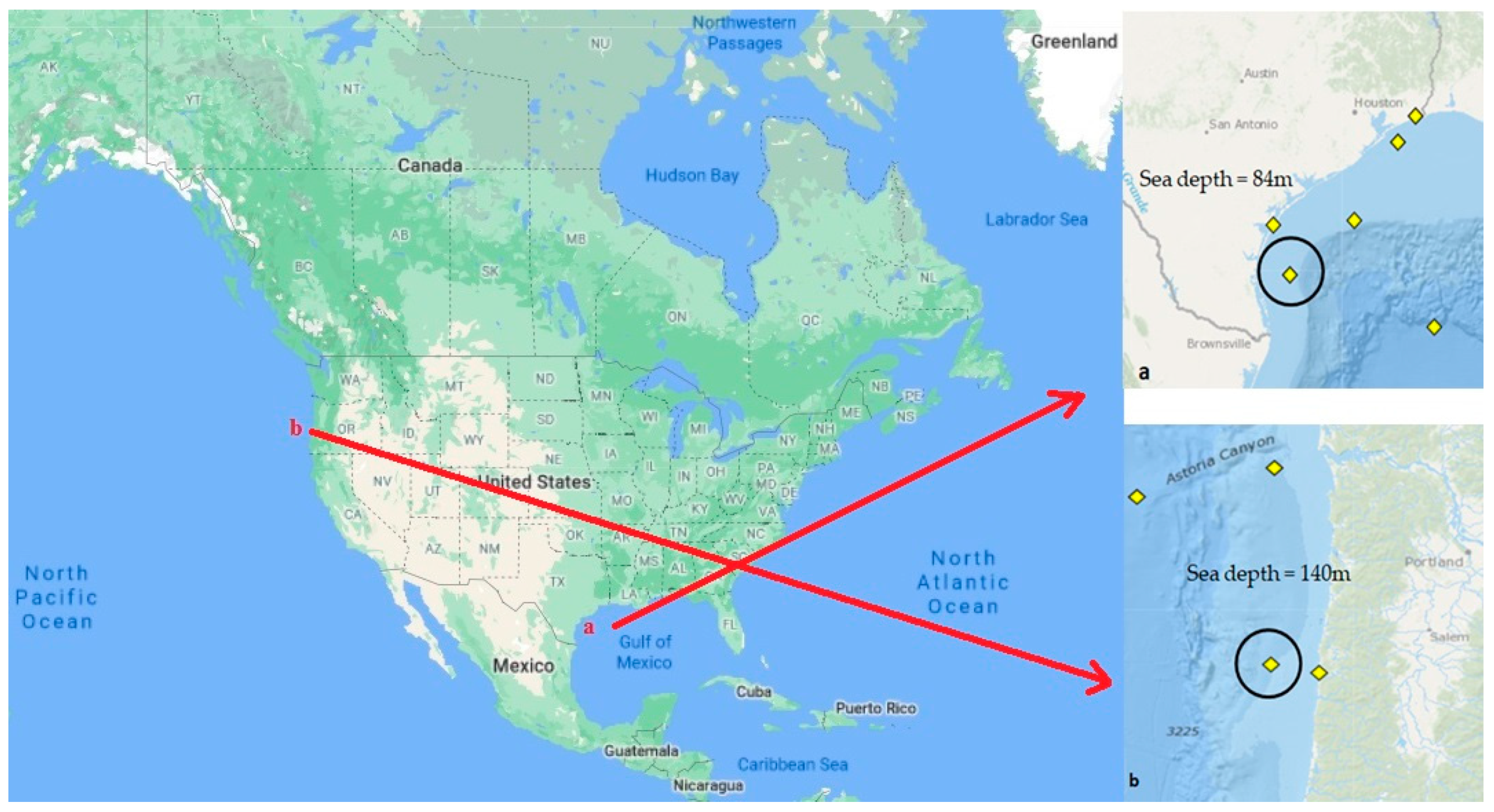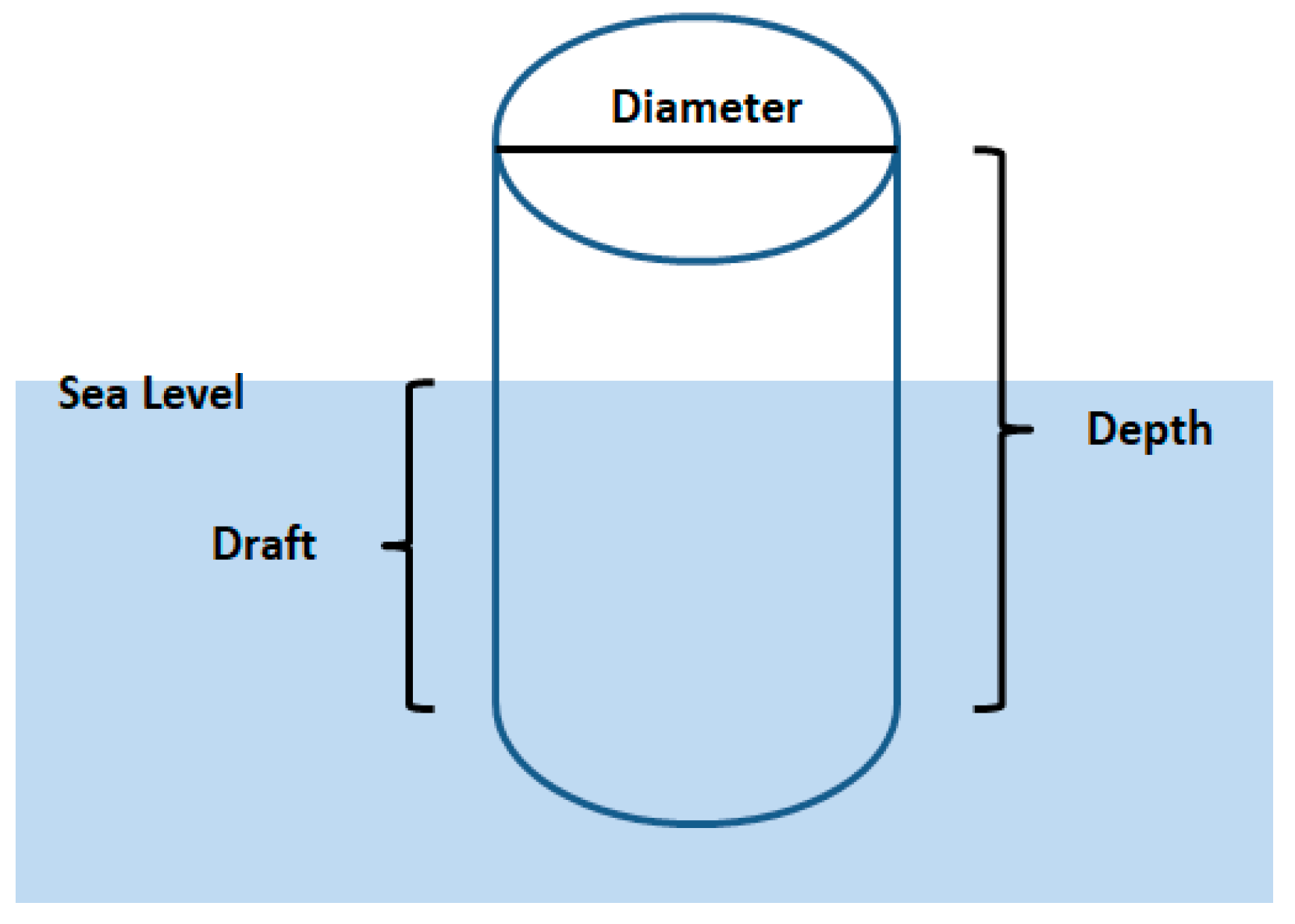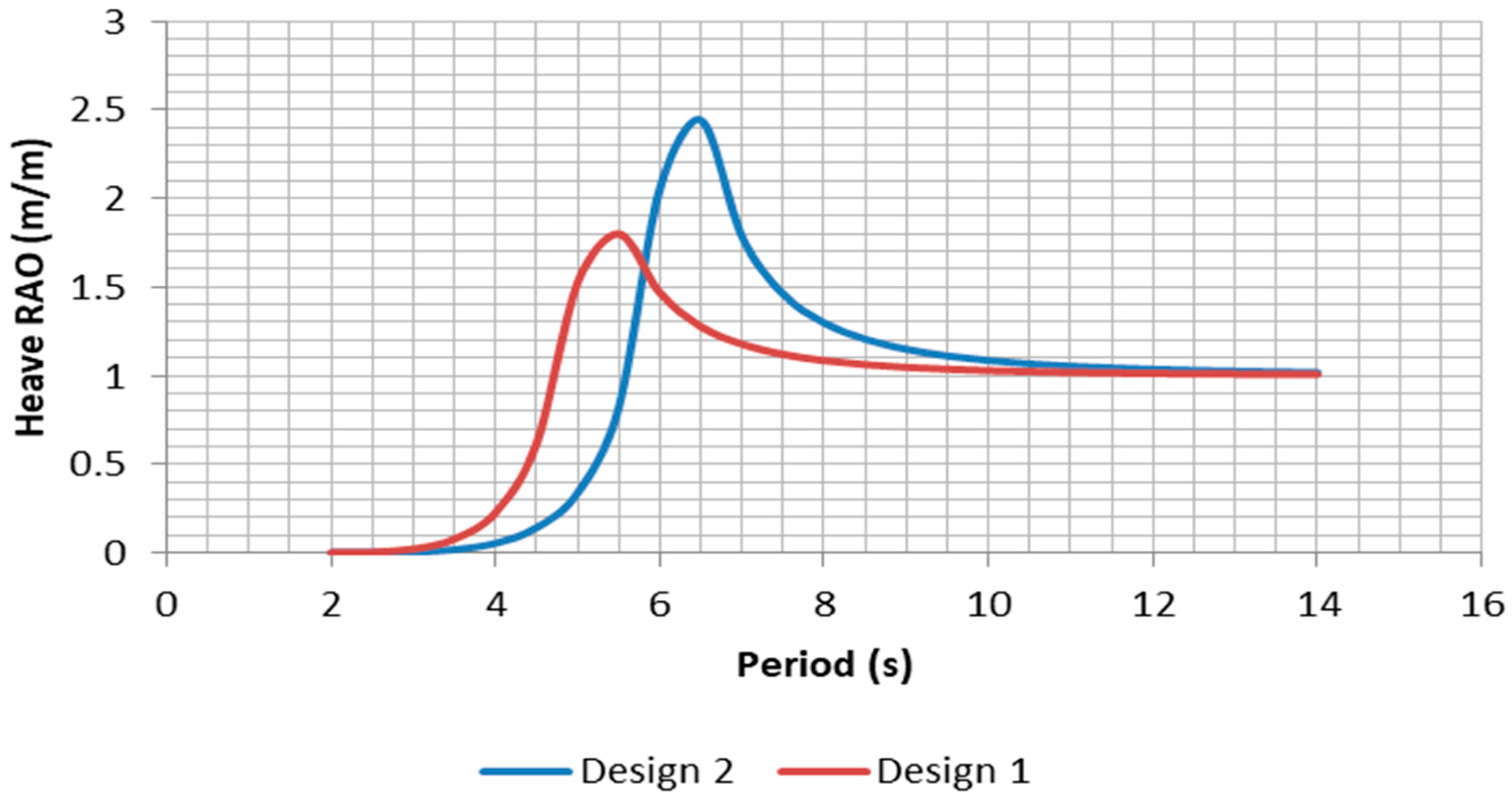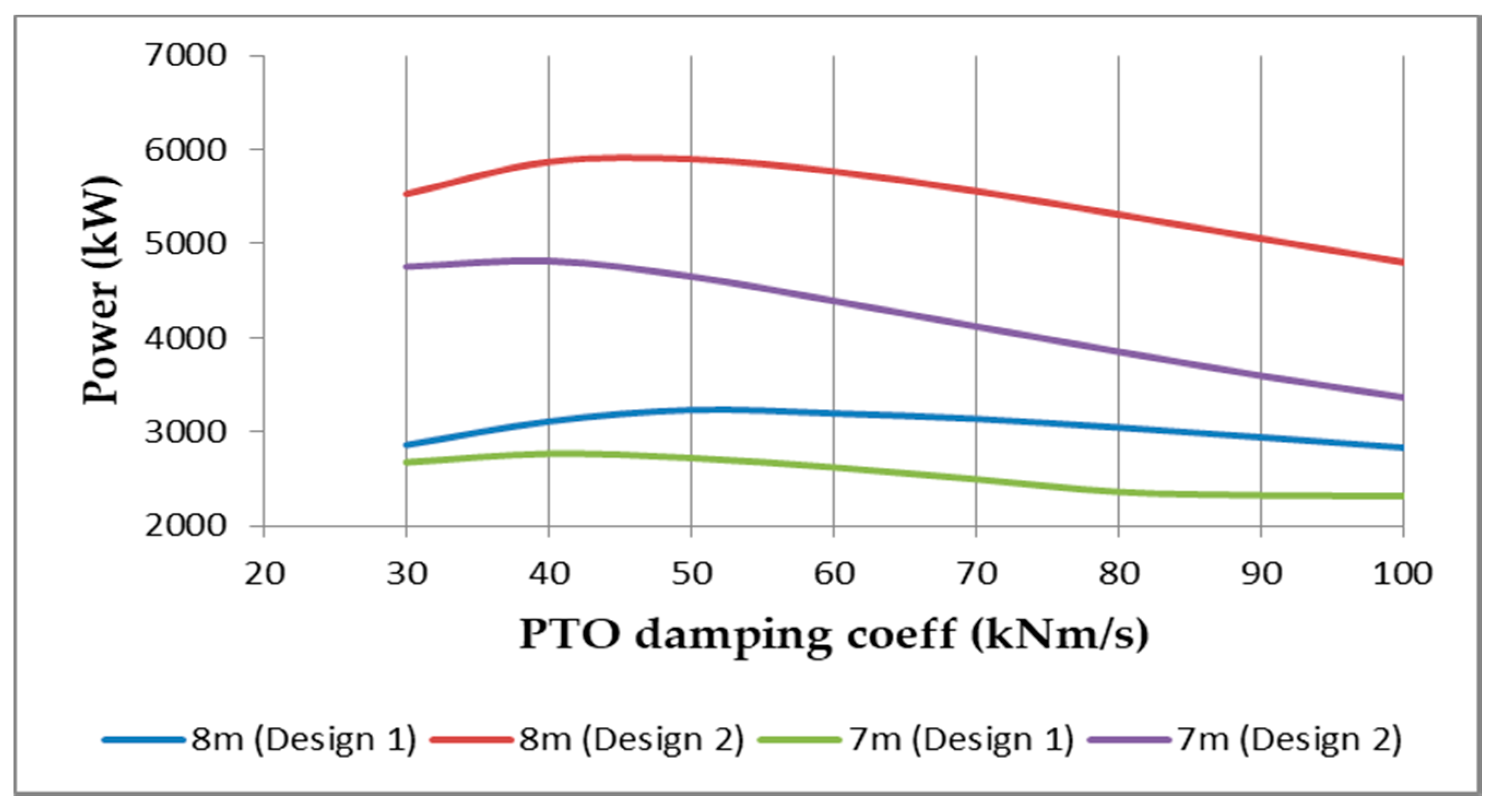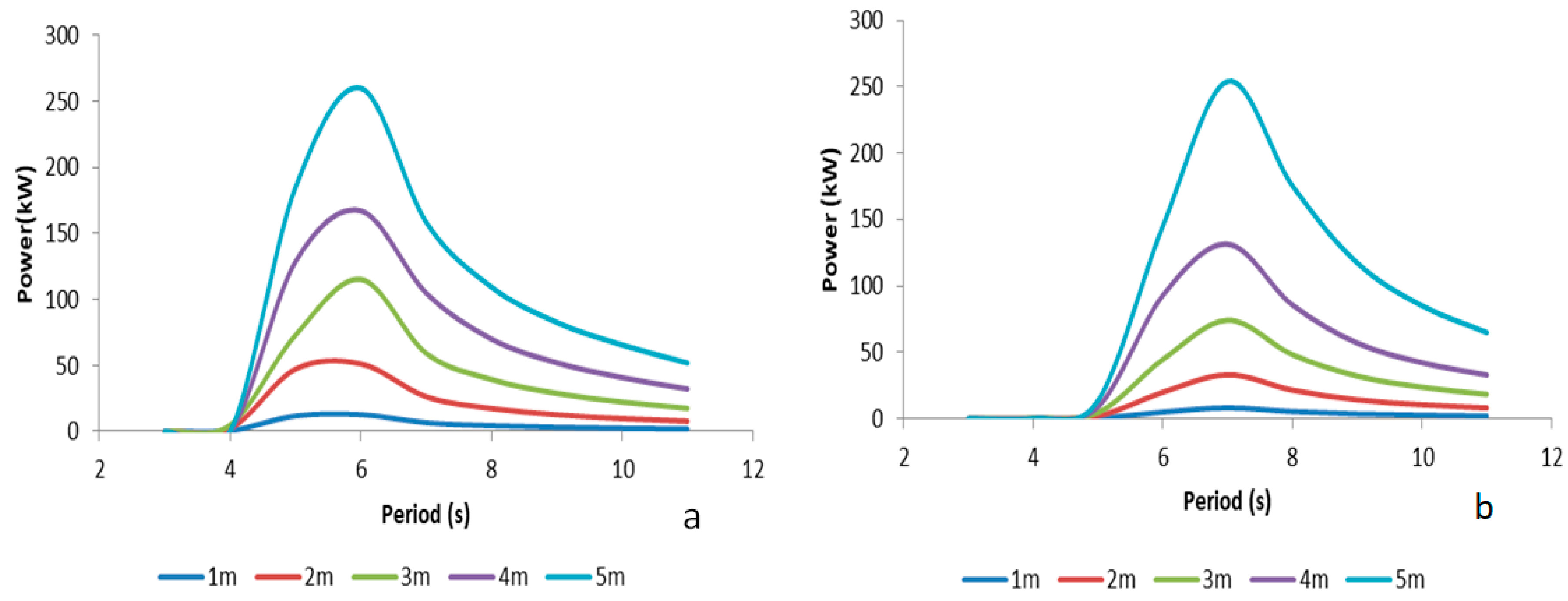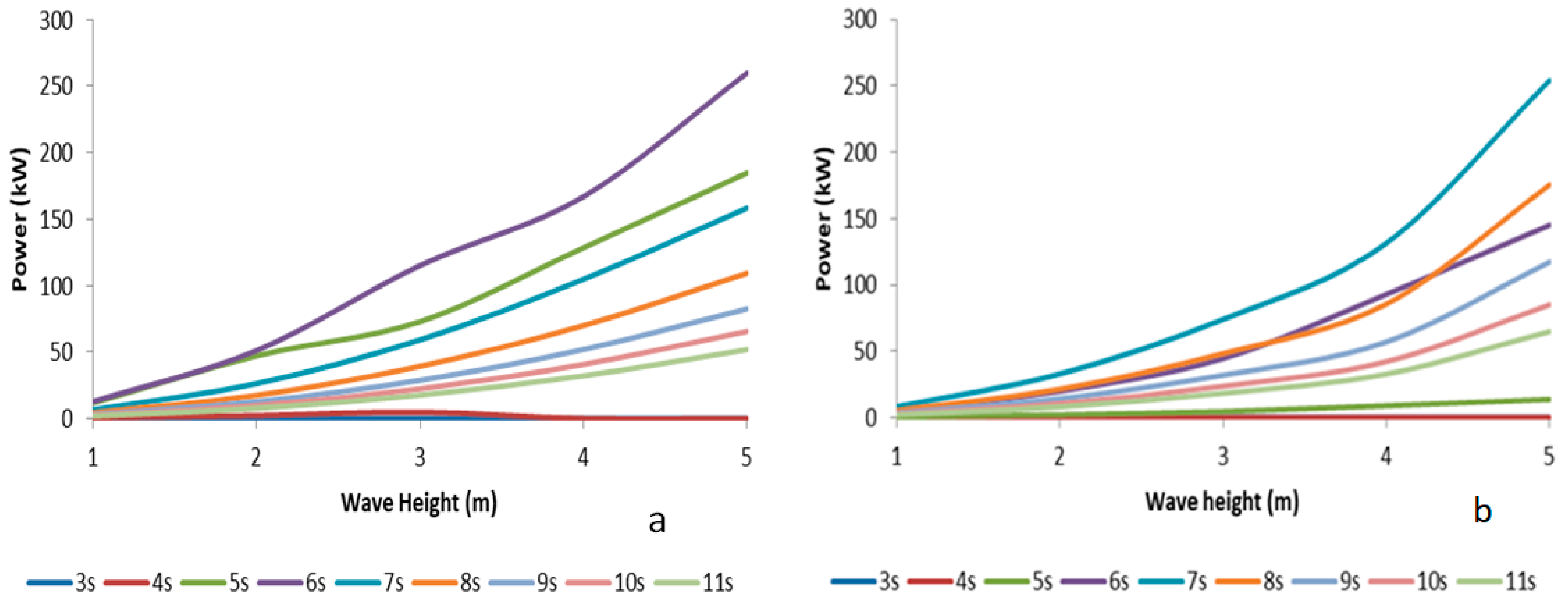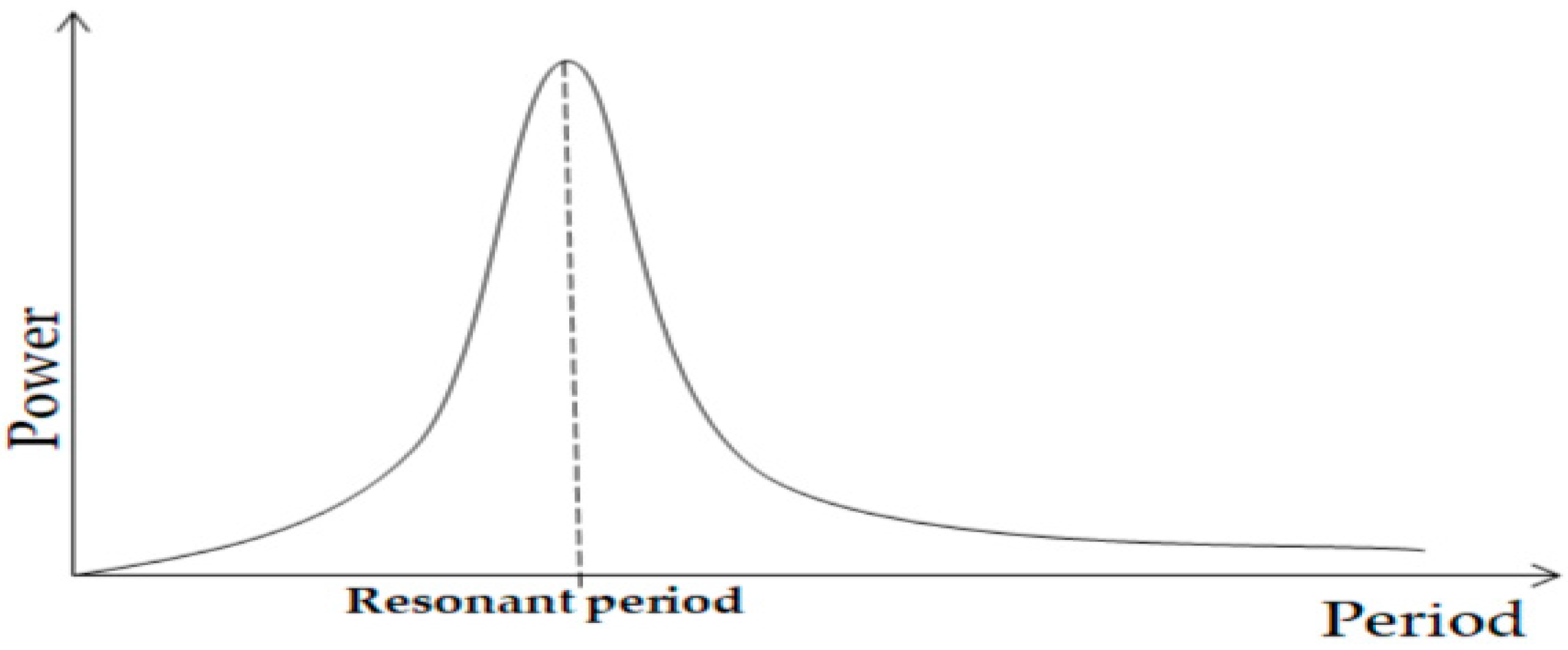1. Introduction
Ocean wave energy has continued to see increase in the level of awareness in recent years. Moreover, the last three to five years have seen a lot of research and development efforts into the ocean wave energy industry [
1,
2,
3]. Others studies focused on specific aspects of the ocean wave energy such as resource characterization have been performed at global [
4,
5], regional [
6,
7,
8] and local levels [
9,
10]. Serious exploration and exploitation of ocean wave energy resources are currently being investigated in U.S. [
3], Europe [
11,
12,
13], China [
14], India [
15], etc. Other aspects of ocean wave energy such as economics [
16], environmental [
17], design [
18] and efficiency and performance [
19] have all being studied by different researchers. Apart from the general aim for ocean wave energy to supply energy into the traditional grid systems, the work done by [
20] investigated the potential of using ocean wave energy to supply power for offshore oil rigs and other offshore structures which can broaden the application of this vast but underutilized energy resource.
Wave energy converters (WECs) can be classified based on their working principles. Another classification method is based on the water depth of the WEC’s site location (shoreline, nearshore and offshore). WECs are also classified based on the ratio of the wavelength magnitude to the interacting part of the WEC. For example, WECs can be classified into oscillating water columns, oscillating body systems and overtopping devices (
Figure 1) based on their working principles. Under this classification, a point absorber, which is when the WEC interacting part dimensions is considerably smaller than that of the interacting ocean wavelength [
21,
22], is considered as an oscillating body-based WEC. It is a terminator if the dominant wave direction is perpendicular to the structural extension of the WEC [
23], while it is an attenuator if its structural extension is parallel to the interacting wave direction [
24].
One of the promising methods of wave energy capture is the oscillating body system. One major thing that makes the use of these types of converters attractive is because the amount of the energy absorbed by the body can be improved upon significantly under the same wave conditions when the body is at resonance with the incoming waves as illustrated in
Figure 2. In fact, the team that won the prestigious ocean wave energy prize offered by the United States Department of Energy developed their concept and design based on a heavingf oscillating buoy [
25]. The Pelamis [
26], which is one of the most studied converters, is a pitching (rotating) oscillating converter and is also another type of a wave activated body system.
The hydrodynamics of oscillating body systems including heaving systems were independently solved by [
27,
28,
29], which show the theoretical maximum energy to be captured by an oscillating body system-based wave energy converter. The results confirm that the highest possible capture occurs when the body is at resonance with the incoming waves. This behavior of a floating oscillating body poses a challenge for WEC designers because a typical body has a narrow resonance frequency band, and the body performs poorly outside this band. Hence, one of the many characteristics of a good oscillating WEC design is to make the buoy resonate to the prevailing ocean wave properties [
2]. It should be noted that other factors, including survivability and profitability, need to be considered as well when designing a WEC. In order to capture considerable power outside the resonance frequency band, different optimization methods have been proposed and investigated. Some optimization methods include changes made to the shape and dimensions of the buoy [
30], while latching and declutching methods [
31] are also used in some existing studies. Latching control is achieved by holding the heaving WEC in a fixed position when the velocity is zero and releasing it at the right time so that its velocity can be in phase with the excitation force to achieve resonance [
32]. On the other hand, declutching works by alternatively switching the power take off system on and off [
31]. Another method is the model predictive control. It is an advanced control strategy [
33] compared to the passive control methods, which may employ complex algorithms and simulations to achieve the optimization of power absorption by the WECs. While these methods have theoretical possibilities, there exists very little information reporting their applications in real ocean conditions.
In all these designs and optimization methods, the ocean wave properties have to be properly characterized first in order to have a good and effective WEC design. Although two ocean wave properties (wave height and wave period) guide the estimation of ocean wave resource potential and power capture of a WEC, it is the wave period that determines how the resonance behavior of a floating body will be engineered so it will operate near resonant level with the desired ocean wave period. There are existing studies that focus on general guidelines for designing a WEC. Meanwhile, most available wave condition database or monitoring/forecasting systems are designed for other marine systems instead of WEC design [
8,
9], so it is important to investigate the possibility of using existing wave condition data on designing a WEC. Instead of optimizing the size of a heaving point absorber WEC, this paper focuses on conducting detailed quantitative analysis on the changes on the power output of a heaving point absorber due to the variation of temporal and spatial resolutions of existing wave condition data. This paper uses available wave condition data from an existing database instead of collecting new wave condition data in the analysis.
Section 2 introduces the methodology used including the ocean wave data analysis in the studied regions, the method for estimating the average yearly energy resource potential as well as the design process for the WEC which led to two different WEC designs in terms of dimensions. In
Section 3, the annual energy resource potential is estimated under three different scenarios based on existing wave condition data: (1) wave data based on hourly resolution at the selected location in the Gulf of Mexico, (2) wave data based on daily resolution at the selected location in the Gulf of Mexico, and (3) wave data based on hourly resolution in an offshore location in Oregon. The power and annual energy matrices of the two WEC designs based on the hourly and daily resolution data are analyzed in
Section 4. The design tailored to the hourly resolution data in the Gulf of Mexico is tested with the hourly data of an offshore location in Oregon, and the results are compared.
Section 5 shows the results of a series of statistical hypothesis analysis such as
t-test using data obtained from the Gulf of Mexico to determine the significance on the power output by different parameters such as diameter, design and seasonal variation (winter and summer).
Section 6 is for discussions and conclusions.
3. Annual Energy Resource Assessment and Estimation
The ocean wave power density in a location is a function of wave height and wave period given by the relation in Equation (6) based on approximation made for deep water condition.
The annual power density can be estimated if information about the percentage occurrence of the wave height/period in the location is available [
2].
where
P (KW/m) is power density (power per unit width of wave front),
ρ (Kg/m
3) is seawater density,
g (m/s
2) is gravitational acceleration,
H (m) is significant wave height and
Te (s) is energy wave period. Since the wave period date provided by National Oceanic and Atmospheric Administration (NOAA) is dominant wave period
Tp, the energy wave period (
Te) is calculated by multiplying a wave period conversion factor α to dominant wave period (
Tp). In this study, the wave conversion factor was considered as 0.9, which is the equivalent of JONSWAP software [
38] and has been used in the past by different studies [
9,
20,
38].
The potential energy density per year is calculated by multiplying the percentage occurrence in a year, and the results for the three different scenarios are provided in the
Table 7,
Table 8 and
Table 9 below. From
Table 7 and
Table 8, the hourly resolution data provides annual energy density potential of 105.3 MWh/m, and the daily resolution data provides annual energy density potential of 102 MWh/m. This shows about 3% difference in terms of energy density potential in the same location with different temporal resolution data. This shows that different temporal resolution of the data in same location may not significantly affect the estimation of the total wave energy resource potential present in the location.
Similarly, the resource potential for the location in offshore Oregon is shown in
Table 9 above. With a yearly total of about 43,374 MWhr/m of wave energy resource potential, it is confirmed that the location is a high wave energy resource area with resources about 40 times higher than that of the location in the Gulf of Mexico.
4. Power Capture of the WEC
Three scenarios of power capture are examined and compared in this section. After a series of computational fluid dynamics (CFD) diffraction analysis using ANSYS/AQWA suite version 18.1, which is based on potential flow theory, the response amplitude operator (RAO) which gives the motion response of the buoy at different periods is given in
Figure 6. The three scenarios and the WEC dimensions are provided in
Table 10. Design 1 was tailored to the dominant wave period based on the hourly resolution data while Design 2 dimensions was engineered to capture power optimally at the dominant wave period based on the daily resolution data from location 1 in the Gulf of Mexico. The power capture of design 1 in location 2 in Oregon is also estimated to investigate the impact of different wave conditions on the same WEC design in terms of power capture.
The power take-off in this study was modeled as pure damper which is assumed to be frequency dependent. The motion equation of the heaving point absorber buoy with the power take off (PTO) can be described by Equation (7) below
where
,
M is mass,
A is added mass,
x is heave displacements and its derivatives with respect to time;
B is damping coefficient and
C is hydrostatic force coefficient;
F(
t) is the external force acting on the buoy while F
PTO is the PTO force; and
DPTO is the PTO damping coefficient.
The maximum amount of energy captured by the buoy occurs when the PTO damping is equal to the radiation damping of the buoy [
39]. Hence the PTO damping will be equal to that of the buoy at resonance. The mean absorbed power by the PTO is given by Equation (8)
where,
ω is the angular frequency at resonance.
Using the premises highlighted above, different values of PTO damping were tested on the buoy and the power capture and are shown in
Figure 7. The maximum occurred when the damping coefficient was 50 kNm/s for both design 1 and design 2 when the diameter of the buoy was 8 m and 40 kNm/s when the diameter of the buoy was 7 m for both design scenarios.
For both designs, the heaving oscillatory motion of the buoy was converted to power through a power take off (PTO). For the purpose of this design, a PTO damping of 40 kNm/s and 50 kNm/s was used for the WEC devices when the diameter of the buoy was 7 m and 8 m, respectively.
Figure 8 and
Figure 9 show the change of the power capture with respect to the wave period and wave height, respectively. The figures show, as expected, the power capture peaks when the wave period is at the resonance period of the buoy. However, the power capture increases almost linearly with wave height increase. Hence, while both wave period and wave height affect the power capture, the relationship between the wave period and power capture of a heaving point absorber is more significant due to the resonant behavior pattern.
The annual energy captured in each bivariate wave height-wave period combinations under different scenarios are given in
Table 11,
Table 12 and
Table 13.
Table 11 shows the yearly energy that can be harvested using design 1 tailored using the hourly data from the GoM, while
Table 12 shows the comparative annual energy based on design 2 tailored using daily resolution data.
Table 13 shows the annual energy by design 1 when operated in the Oregon location, an offshore region with over 40 times the wave energy potential compared to location 1 in the GoM. When the wave height-wave period combination did not exist due to physics of wave formation, “NA” is input in the tables, while a “0” in the table means the occurrence of that specific combination was zero in the specific time and location.
The result shows that the total annual energy capture under Scenario 1 was about 212 MWh/yr while Scenario 2 had about 178 MWh/yr. Scenario 3 had about 150 MWh/yr. The results show about 16% difference between Scenarios 1 and 2. It is also interesting to note that the annual energy performance estimation of design 2 was lower than that of that of design 1 even though the dimensions of design 2 were larger. It can be inferred that the temporal resolution of the ocean wave data also significantly affects the overall energy performance of the device in addition to significantly affecting the dimensions of the WEC buoy. When comparing Scenario 1 with Scenario 3, despite the buoys in both scenarios having the same dimensions, the total annual estimated energy capture in Scenario 1 was about 41% greater than that of the Scenario 3 even though the total annual energy theoretical potential in location 2 is over 40 times greater than that of location 1. This reinforces the idea that heaving buoys should be designed and tailored to specific locations. In the next section, the factors involved in the power capture estimation in this paper are further analyzed by conducting detailed statistical analysis.
5. Design Parameters and Their Effects on WEC’s Power Output
Different parameters and their effects on the WEC’s power production are tested using statistical hypothesis testing methods such as t-tests and factorial analysis. These tests have given more insights into the complexities that exist between some of different parameters that contribute to the energy produced by a WEC. Real ocean data of a 7-day period randomly picked from summer (July, 13–19) and winter (Jan, 1–7) in the GoM. One summer week and one winter week wave data are extracted including both hourly resolution (168 data points) and daily resolution (7 data points). The power output of WECs with different design parameters including design types (design 1& design 2) and diameters (7 m & 8 m) are estimated under the two weeks wave data. These estimated power output values are used as samples for the hypothesis testing. For the two-sample two-tailed t-test under hourly and daily data, each sample has 168 and 7 data points, respectively. For the factorial analysis, the estimated power output values are considered as the response/variable, and design type, diameter, and season are considered as factors with each factor having two different levels.
For the hourly resolution data within the week used for design 1, the standard deviations of the wave height and wave period are 0.32 m and 1.03 s for the summer and 0.65 m and 1.05 s for the winter. Similarly, for the daily resolution data used for design 2, the standard deviations of the wave height and wave period are 0.25 m and 0.69 s for the summer and 0.54 m and 0.78 s for the winter. As described in previous sections, design 1 is tailored to capture highest energy between 5–6 s (RAO = 5.5 s), and design 2 is tailored to capture most energy between 6–7 s (RAO = 6 s). So the distribution of wave period within the selected period does influence the results. For the winter season, the wave period falls below 6 s for 95 times out of 168 for the hourly resolution data and 4 times out of 7 times for the daily resolution data. Similarly for the summer season, the wave period falls below 6 s for 23 times for the hourly data and zero time for the daily data. The results of the two-sample two-tailed
t-tests are shown in
Table 14, where the estimated power outputs are the samples.
From the results, a p-value less than or equal to 5% indicates that the variables (parameters) significantly influenced the power output. First, different designs (design 1 versus design 2) significantly affected the power output irrespective of the season and diameter. Second, for the seasonal variations, most results were significant except for when the diameter was 7 m in design 2. Last, the size of the diameters in most cases significantly affected the power output of the device, except for design 1 during the winter time.
The factorial analysis was performed on the power output with design, diameter and season as the factors. Each factor had two different levels, so a 2
3 factorial design was formed and tested. The results from the factorial analysis are shown in
Table 15. The results show a
p-value of less than 5% for all the main effects and interaction between design and season, while the remaining two-way and three-way interactions were not significant.
6. Conclusions
The effects of the spatial and temporal resolution of the ocean wave data on the design of heaving point absorber and its power capture have been analyzed in this study. The effects have been analyzed quantitatively by comparing power capture performance of different designs of heaving point absorber based on different temporal and spatial wave conditions. By applying the normal convention to design the WEC device to resonate, it would capture energy in the most prevalent ocean wave period. The results show that different temporal resolution data lead to different designs, which may capture different amount of energy. However, the difference in temporal resolution of data did not significantly affect the estimation of the ocean wave theoretical power present in a location.
The results confirm the importance of designing a WEC device specific to a location. The WEC device designed to operate in a region in the Gulf of Mexico may generate much less energy in an offshore location in Oregon, even though Oregon location has almost 40 times more ocean wave energy potential than the location in the Gulf of Mexico. Results of these analysis show that the power captured by the same device in the Gulf of Mexico was higher despite having lesser wave energy potential. This is because the WEC was designed to resonate with the prevalent ocean wave condition in the Gulf of Mexico, so its performance was poor in the Oregon location. The influence of the WEC design, diameter and seasonal changes were also examined on the power output of the device. These effects were analyzed using t-tests and factorial analysis. The results show that all the parameters to varying degrees have significant effect on the power output. However, only the interaction between design and season shows significant effect. Furthermore, a linear damper of 40 kNm/s and 50 kNm/s was used in this paper to represent the power take off for the 7 m and 8 m buoy. Future studies will perform sensitivity analysis to determine the optimal damper and its nonlinear behavior.
Studying the complexities that exists in the interaction of WEC devices with the ocean waves will increase the knowledge in the design of more effective devices, which will make the penetration of ocean wave energy increase. The scope of this study deals with only the primary capture of mechanical energy from the ocean waves through the hydrodynamic interaction of the WEC device and is most useful at the feasibility stage of the project. This aspect is only a part of the wave energy process, which includes the hydrodynamic conversion, conversion to electrical energy, and transmission. The wave condition data used in this paper was obtained from NOAA directly, which provides hourly and daily resolution. During the feasibility analysis stage of wave energy harvesting and WEC design, it was possible to directly use existing wave condition data with default temporal resolution as many existing studies did [
4,
6,
8,
40,
41,
42,
43,
44,
45]. Meanwhile, IEC TC114 technical specification recommends 30 min temporal resolution when designing WECs for commercial use. Decision makers and WEC designers should choose the right temporal resolution based on different needs and budget limitations. As the commercialization of WECs draws more attention, it is expected more wave condition data with 30 min temporal resolution may become available, which could reduce the additional cost for collecting wave energy data for WEC designs. In addition, the structural reliability of any WEC devices should also be considered in the design stage, especially their reliability under extreme and hash ocean wave conditions.
